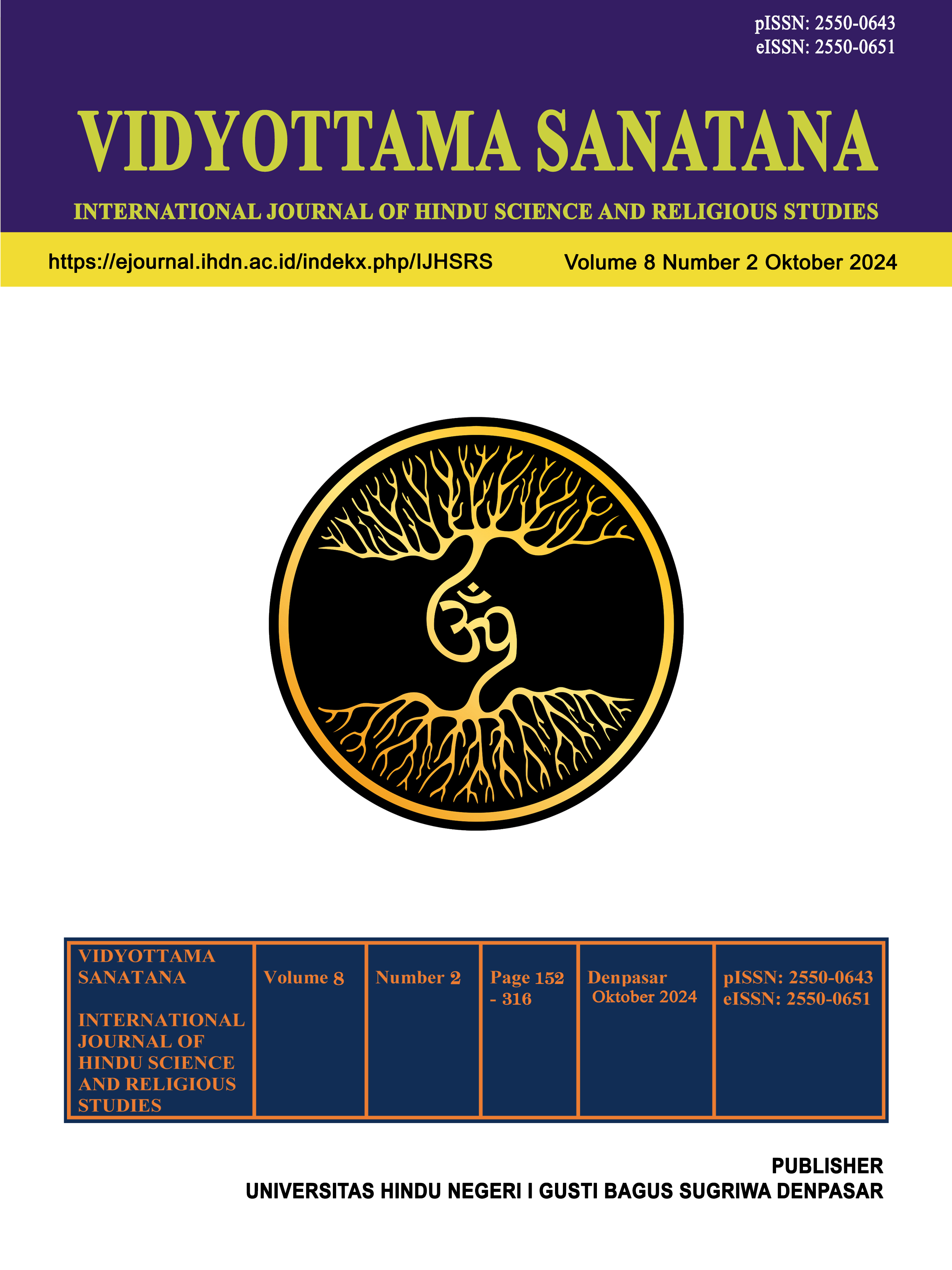THE WISDOM OF WAYANG KAMASAN: A MORAL COMPASS FOR SUSTAINABILITY
DOI:
https://doi.org/10.25078/vidyottama.v8i2.3468Keywords:
Wayang kamasan, axiology, moral, sustainabilityAbstract
The deterioration of the Earth's ecosystem and its subsequent impact represents a mounting concern. The increase in crimes against humanity, the destruction of the natural world, and the extinction of animals is a matter of grave concern. The objective of science is to address the damage through a scientific approach. However, in order to instill a sense of moral responsibility, it is becoming increasingly necessary to adopt an approach that is rooted in ancient traditions. This paper focuses on wayang kamasan, a traditional communal art that has been maintained since the 14th century and is synonymous with value-laden tradition. The objective of this paper is to examine the wisdom of wayang kamasan from the perspective of Emmanuel Levinas' moral philosophy in order to ascertain its relevance in the context of sustainability. The research analysis revealed that the values inherent to wayang kamasan encompass transcendent, wisdom, vital, and utilitarian values. These values represent the nexus of artistic practice and traditional aesthetics, influencing spiritual experience, moral conduct, and the exercise of wisdom in action. The wisdom inherent in wayang kamasan offers a robust foundation for directing moral responsibility towards sustainability.
References
Adger, W. N., Barnett, J., Brown, K., Marshall, N., & O’Brien, K. (2013). Cultural dimensions of climate change impacts and adaptation. Nature Climate Change, 3(2), 112–117. https://doi.org/10.1038/nclimate1666
Ahmad, T. A. 2017. "Mengurai Makna Lukisan Kamasan Di Puri Klungkung". Indonesian Journal of Conservation, 5(1), 56–66.
Asmiwyati, I. G. A. A. R., Mahendra, M. S., dkk. 2015. "Recognizing Indigenous Knowledge on Agricultural Landscape in Bali for Micro Climate and Environment Control". Procedia Environmental Sciences, 28, 623–629. https://doi.org/10.1016/j.proenv.2015.07.073.
Järvelä, M. (2023). Dimensions of cultural sustainability—Local adaptation, adaptive capacity and social resilience. Frontiers in Political Science, 5. https://doi.org/10.3389/fpos.2023.1285602
Jirzanah 2016. "Aktualisasi Pemahaman Nilai Menurut Max Scheler Bagi Masa Depan Bangsa Indonesia". Jurnal Filsafat, 18(1), 93–114. https://doi.org/10.22146/jf.3519.
Kakoty, S. 2018. "Ecology, sustainability and traditional wisdom". Journal of Cleaner Production, 172, 3215–3224. https://doi.org/10.1016/j.jclepro.2017.11.036.
Kompas 2022. "Pandemi Covid- 19 Dalam Lukisan Wayang Klasik". Indonesia: Kompas TV, diambil dari https://dai.ly/x87tdcg.
Laksmi, R. S. 2013. "Nuansa Kearifan Lokal Situs Kerta Gosa dalam Mengkonstruksi Jatidiri pada Era Global". Forum Arkeologi, 26(3), 207–216.
Lasminah, P. 1981. Ida Bagus Gelgel Hasil Karya dan Pengabdiannya. (S. Kutoyo, M. S. Kartadannadja, dkk., Ed.), 1 ed. Jakarta: Departemen Pendidikan dan Kebudayaan Direktorat Sejarah dan Nilai Tradisional..
Lemanto, E. 2022. "Beyond Dialogue: Etika Dialog Emmanuel Levinas". Jurnal Sosial Humaniora, 02(01), 26–39.
Levinas, E. 1984. "Ethics and Infinity". CrossCurrents, 34(2), 191–203. diambil dari http://www.jstor.org/stable/24458756.
Levinas, E. 2007. Totality and Invinity: An Essay on Exteriority (Translated by Alphonso Lingis), 20 ed. Pittsburgh, Pennsylvania: Duquesne University Press.
MacArthur, J. L., Hoicka, C. E., dkk. 2020. "Canada’s Green New Deal: Forging the socio-political foundations of climate resilient infrastructure?". Energy Research & Social Science, 65, 101442. https://doi.org/10.1016/j.erss.2020.101442.
McGlynn, D. E., dan Gunderman, R. B. 2014. "Learning to See: The Moral Opportunity of Art". Journal of the American College of Radiology, 11(6), 536–539. https://doi.org/10.1016/j.jacr.2013.06.011.
Munteanu, L. H., Croitoru, I., dkk. 2013. "Art and Moral Values - A Pedagogical Approach Through the Hexadic Model". Procedia-Social and Behavioral Sciences, 83, 437–442. https://doi.org/10.1016/j.sbspro.2013.06.086.
Parmono, R. 1993. "Konsep Nilai Menurut Max Scheler". Filsafat, (16), 43–51.
Powers, R. P., dan Jetz, W. 2019. "Global habitat loss and extinction risk of terrestrial vertebrates under future land-use-change scenarios". Nature Climate Change, 9(4), 323–329. https://doi.org/10.1038/s41558-019-0406-z.
Ramli, W. N. R. W., dan Lugiman, F. ‘Aini 2012. "The Contribution of Shadow Puppet’s Show through Engaging Social Communication in Modern Society". Procedia - Social and Behavioral Sciences, 35, 353–360. https://doi.org/10.1016/j.sbspro.2012.02.098.
Rosala, D. 2016. "Pembelajaran Seni Budaya Berbasis Kearifan Lokal dalam Upaya Membangun Pendidikan Karakter Siswa di Sekolah Dasar". Ritme, 2(1), 1–26.
Roth, D., dan Sedana, G. 2015. "Reframing Tri Hita Karana : From ‘Balinese Culture’ to Politics". The Asia Pacific Journal of Anthropology, 16(2), 157–175. https://doi.org/10.1080/14442213.2014.994674.
S. Iswidayati Isnaoen 2006. Pendekatan Semiotik Seni Lukis Jepang Periode 80-90an; Kajian Estetika Tradisional Jepang Wabi Sabi, Unnes Pres. Semarang.
Sobon, K. 2018. "Etika Tanggung Jawab Emmanuel Levinas". Jurnal Filsafat, 28(1),47. https://doi.org/10.22146/jf.31281.
Soetomo, G. 2003. Krisis Seni Krisis Kesadaran, 1 ed. Yogyakarta: Kanisius.
Sukarma, I. W. 2016. "Tri Hita Karana: Theoretical Basic of Moral Hindu". International Journal of Linguistics, Literature and Culture. https://doi.org/10.21744/ijllc.v2i3.230.
Winkler, K., Fuchs, R., dkk. 2021. "Global land use changes are four times greater than previously estimated". Nature Communications, 12(1).


















